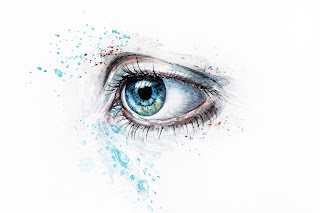Today I'm going to talk about vitreous
opacities and vitreous floaters so I
wanted to express some gratitude for a
couple people one is Lilian in our
office who has helped us extensively
with our presentations and I'm really
grateful to her for that and this is a
picture of her here and also I'd like to
express gratitude to Geri seabag who is
a virtual retinal surgeon in California
who has been a pioneer in vitreous
opacities and floaters and not only
is he a a very erudite and sophisticated
person but he is he has been
consistently and politely pushing this
field forward for many decades
particularly given the attitude that
many of us have towards patients with
floaters and dismissing their symptoms
and he's been very gently and
persistently moving the field in the
right direction so first we'll start
with vitreous Anatomy and over here on
on the Left panel you can see a autopsy
eye in which the choroid the sclera was
removed and the choroid was detected
anteriorly and then the vitreous base
was the second off of the retina and you
could see that early in life the
vitreous gel is firm it's very clear and
and it's it has a structure.
It doesn't
just collapse when you set it on a on a
surgical cloth and if we look at the
iron cross section we can see that the
the vitreous emanates from the aura
sirata and it's always connected to this
space during life there's a little space
right here and then the vitreous is
connected to the lens and this space
here behind the lens that posterior
capsule is called Berger space or the
retro mental space of galette
there are fibers that extend up to the
pars plana and even the pars Picatta and
these aren't shown on this diagram but
we know that those exists because when
we're opera
patients with proliferative retinal
diseases we can see contraction with the
retina actually gets pulled from here up
onto the ciliary body and by coming
across with a cutter in shaving those
vitreous bands we can release that
traction
there's cloak haze canal which emanates
from the disk and if we blow the space
up here we can see this this area a
little better there's this little space
here a little space behind the capsule
and then this type adhesion between the
anterior vitreous face and the posterior
capsule and this is why cataract
surgeons get vitreous loss when they
break the posterior capsule it isn't
because they're you know going crazy
back here it's it's because whenever the
capsule is torn it often actually
breaches the vitreous phase right here
if we look during development at a
neonatal or our embryonic eye we see the
the lens with the embryonic nucleus and
the fetal nucleus and then we see the
tunic of a skull osa lentes which is
contiguous with cloakers canal and this
branch of vessels and this regress is
overtime and forms a a little tuft in
adults this is a a embryonic or neonatal
lens and when we do retinopathy
prematurity exams which I don't do
anymore but I did when I ran the
neonatal intensive care unit service at
Parkland Memorial Hospital in Dallas we
can see these these lenses these blood
vessels on the lense in fact when we're
doing laser for retinopathy prematurity
we try to avoid the bigger lenses into
order to avoid causing a sub capsular
cataract and here is an example of a
incompletely regressed Bergmeister is
patella the remnant of the Clos case
canal and this is a picture from dr.
Henry Kaplan who is a famous
ophthalmologist in Louisville
specializes specialists and many things
including you be honest so here are some
some work where we're comparing an
embryonic vitreous
to a middle-aged vitreous to an aged
vitreous and one of the problems we have
with examination of the vitreous is that
the optics aren't ideal we're unable to
get the slit arm far enough over to
examine the posterior vitreous
effectively because of the optics of the
pupil and if we take the vitreous out
and then look at it with these effects
we can create what's called a Tyndall
effect and we can see that in the
e




























